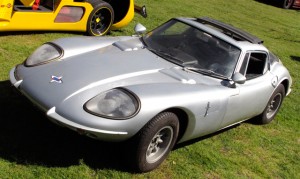 In honor of Earth Day we present a car made largely of wood and glue. The 1967 Marcos GT is comprised of a sandwich of plywood and fiberglass that forms its gorgeous monocoque body. The resulting lightweight sports car is underpinned by conventional metal suspension bits, and what we can only assume is a powertrain that employs sophisticated metallurgy instead of Douglas Fir or Mahogany. This is not the first time the British have used wood in the construction of high-performance machines. The World War II de Havilland Mosquito twin-engine bomber was made by skilled craftsman using Ecuadorean balsa wood and Canadian birch along with a then new technological breakthrough called plywood, all bonded together with milk-derived Casein glues. This Timber Terror was so fast that it went out on bombing missions unarmed, as no enemy aircraft were fast enough to catch the Mosquito in the early part of the war.
In honor of Earth Day we present a car made largely of wood and glue. The 1967 Marcos GT is comprised of a sandwich of plywood and fiberglass that forms its gorgeous monocoque body. The resulting lightweight sports car is underpinned by conventional metal suspension bits, and what we can only assume is a powertrain that employs sophisticated metallurgy instead of Douglas Fir or Mahogany. This is not the first time the British have used wood in the construction of high-performance machines. The World War II de Havilland Mosquito twin-engine bomber was made by skilled craftsman using Ecuadorean balsa wood and Canadian birch along with a then new technological breakthrough called plywood, all bonded together with milk-derived Casein glues. This Timber Terror was so fast that it went out on bombing missions unarmed, as no enemy aircraft were fast enough to catch the Mosquito in the early part of the war.
Constructing airplanes during a war from materials derived from trees and milk was good thinking on the part of a resource strapped Britain. As history would have it, Marcos co-founder Frank Costin worked building Mosquito Bombers during the war, and brought with him the skills required to make automobiles in the same manner. The lessons learned during conflict carried over to the early peacetime Marcos GT cars, which tipped the scales just over 1000 pounds. Sadly, the Marcos GT wood and fiberglass construction formula was abandoned in the late sixties in favor of steel tubing in order to speed up production and allow for more powerful engines. Since wood and glass are renewable and recyclable resources, constructing lightweight sports cars of wood laminates made from toothpick trimmings and fiberglass spun from RC Cola bottle glass cullet may be an idea whose time has come again.










I believe that Marcos used 4 cylinder engines from Volvo, probably the Amazon. It may not be true of all of them though.
Beautiful writing, Mikey B!!! Fabulous background on the Mosquito and Costin. I had a Dinky Toy 1:43 scale Marcos when I was a tadpole and have had a soft spot (Fontanelle) for Marcos cars ever since.
They mostly used English Ford engines, I believe; the Volvos went into the last of the wooden ones, and that would be my choice. An unbreakable engine in an unrustable car!
Aside from the difficulty of building a unit-construction car with marine ply and glue in any kind of a hurry, the only real problem is grounding the electrics, all of which of course has to be done by wire. I love these things – just wish they’d been prettier.